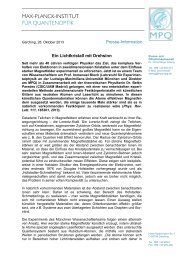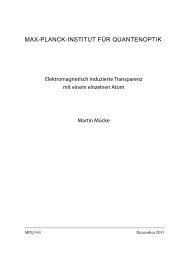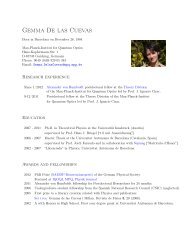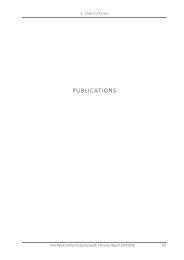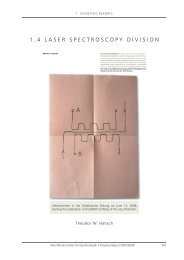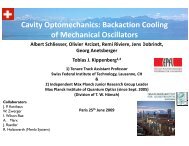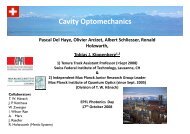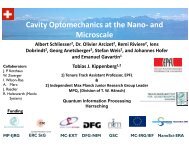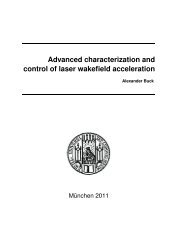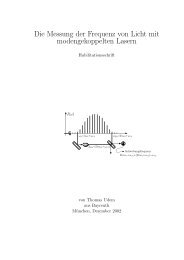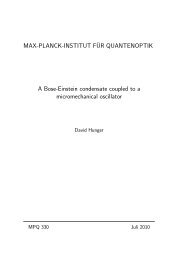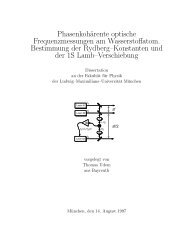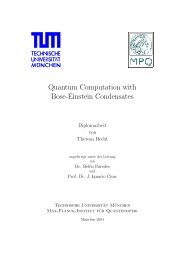Attosecond Control and Measurement: Lightwave Electronics
Attosecond Control and Measurement: Lightwave Electronics
Attosecond Control and Measurement: Lightwave Electronics
You also want an ePaper? Increase the reach of your titles
YUMPU automatically turns print PDFs into web optimized ePapers that Google loves.
1 . 3 AT T O S E C O N D A N D H I G H - F I E L D P H Y S I C S D I V I S I O N<br />
which are shown in Figure 7, indicate sub-femtosecond<br />
emission time for both types of electrons. Closer<br />
inspection has yielded a discernible temporal shift<br />
between the two streaking spectrograms: careful data<br />
analysis reveals a delay in emission of the core electrons<br />
with respect to the conduction-b<strong>and</strong> electrons of about<br />
110 attoseconds. This means that the former reach the<br />
surface – from the several-Angstrom depth which they<br />
can escape from – some 110 as later than the latter. The<br />
analysis of Pedro Echenique has revealed that only half<br />
of this delay can be accounted for by the lower kinetic<br />
energy of core electrons, the other half is attributed to<br />
a larger effective mass of these electrons. This proof-ofconcept<br />
study opens the door for direct time-domain<br />
access to a wide range of hyperfast electron processes<br />
in solids <strong>and</strong> surfaces, such as e.g. charge transfer in<br />
host-guest systems or within molecular assemblies on<br />
surfaces, charge screening <strong>and</strong> e-e scattering in metals,<br />
or collective motion in surface plasmons.<br />
After being successfully demonstrated in atoms <strong>and</strong><br />
solids, attosecond spectroscopy now remains to be<br />
extended to molecular systems. As a matter of fact,<br />
the valence electronic states are typically separated by<br />
one or more electronvolts, indicative of a hyperfast<br />
motion of electron wavepackets composed of such<br />
states. The few-femtosecond-duration broadb<strong>and</strong><br />
deep UV <strong>and</strong> VUV pulses reported in Chapter 1.3.1.1<br />
lend themselves to launching electron wavepackets<br />
on molecular orbitals with substantial probability,<br />
whilst synchronized attosecond XUV pulses would<br />
ideally suit for probing the unfolding electronic <strong>and</strong><br />
structural dynamics in molecules. Both of these tools<br />
are derived from waveform-controlled few-cycle NIR<br />
pulses, our basic tool, which ensures attosecond<br />
synchronism between the deep-UV/VUV <strong>and</strong> XUV<br />
pulses. In order that these tools become available for<br />
real-time observation of hyperfast electronic motion<br />
as well as complex, intertwined electronic <strong>and</strong> nuclear<br />
dynamics in molecules, Marcus Fieß, Wolfram Helml,<br />
<strong>and</strong> Eleftherios Goulielmakis – under the guidance of<br />
Reinhard Kienberger – have developed a next-generation<br />
attosecond beamline: AS-2, which accommodates two<br />
frequency-conversion assemblies, for attosecond XUV<br />
<strong>and</strong> few-femtosecond UV/VUV pulse generation. Both<br />
beams can be recombined on target with attosecond<br />
timing accuracy.<br />
Encouraged by the successful extension of attosecond<br />
spectroscopy to solids [10], a team led by Reinhard<br />
Kienberger: Elisabeth Magerl, Adrian Cavalieri, <strong>and</strong> Ralph<br />
Ernstorfer – in close cooperation with our MAP partners:<br />
Peter Feulner, Dietrich Menzel <strong>and</strong> Johannes Barth from<br />
the Technische Universität München, are developing<br />
the world’s first ultrahigh vacuum beamline for<br />
attosecond surface <strong>and</strong> solid-state spectroscopy: AS-3.<br />
We are hopeful that measurement in AS-2 <strong>and</strong> AS-3<br />
will make several contributions to the highlights of our<br />
forthcoming progress report.<br />
ADVANCING TIME-RESOlVED METROlOGY INTO<br />
ThE SUB-100-AS DOMAIN<br />
is indispensable for direct time-domain insight into<br />
electron correlations on the atomic scale. These govern<br />
or affect such fundamental processes as the intraatomic<br />
energy transfer between electrons, the response<br />
of atomic electron systems to external influence, or its<br />
rearrangement following the sudden loss of one or more<br />
electrons. Detailed insight into the electronic response<br />
of atomic-scale solid-state structures to strong external<br />
fields of infrared or visible light, e.g. via non-adiabatic<br />
tunneling is required for the development of solid-state<br />
lightwave electronics <strong>and</strong> will also rely on sub-100-as<br />
temporal resolution.<br />
By confining optical field ionization to a single, wellcontrolled<br />
light oscillation period, the sub-1.5-cycle NIR<br />
laser pulses described in Chapter 1.3.1.1 along with<br />
novel broadb<strong>and</strong> XUV multilayer mirrors developed<br />
by Michael Hofstetter <strong>and</strong> Ulf Kleineberg have recently<br />
permitted our team, Eleftherios Goulielmakis, Martin<br />
Schultze <strong>and</strong> coworkers, to generate isolated sub-100as<br />
pulses of XUV light [29], the measured XUV pulse<br />
profile <strong>and</strong> the NIR electric field waveform are shown<br />
in Figure 8. Detailed evaluation of the measurement<br />
has been performed with a new algorithm developed<br />
by Justin Gagnon <strong>and</strong> Vladislav Yakovlev [30]. The<br />
quasi-monocycle driving field benefits attosecond pulse<br />
generation in several ways. Abrupt onset of ionization<br />
within a single half cycle minimizes the backgroundfree<br />
electron density at the instant of harmonic pulse<br />
emission, minimizing thereby distortion of the driving<br />
wave <strong>and</strong> its dephasing with the generated harmonics<br />
during propagation. Hence coherent build-up of the<br />
harmonic emission over extended propagation is<br />
maximized. In addition, order-of-magnitude variation of<br />
the ionization probability between adjacent half-cycles<br />
creates unique conditions for single sub-100-as pulse<br />
emission without the need for sophisticated gating<br />
techniques.<br />
On the measurement side, improved resolution results<br />
from three (almost equally) important advances: (i)<br />
shorter XUV pulse duration, (ii) higher signal-to-noise<br />
ratio (S/N) <strong>and</strong>/or shorter overall measurement time due<br />
to the increased XUV photon flux, <strong>and</strong> (iii) the feasibility<br />
of stronger streaking before the onset of the NIR-fieldinduced<br />
ionization in attosecond streaking or enhanced<br />
S/N due to reduced number of tunnelling steps in<br />
attosecond tunnelling spectroscopy.<br />
Consequences of these favourable conditions include the<br />
routine generation of isolated sub-100-as XUV pulses<br />
(at a carrier photon energy of about 80 eV), for details<br />
140 Max-Planck-Institut für Quantenoptik • Progress Report 2007/2008



